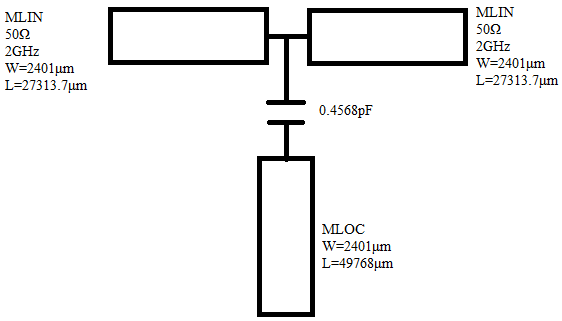Coupling Capacitors to Gaps
I have designed a band stop filter with shunt capacitivley coupled L/C resonators, I have then converted those resonators to open circuit stubs and finally converted the whole circuit to microstrip lines. I am now stuck for weeks trying to convert the coupling capacitors to microstrip gaps and I cannot find any way to do that.
What I Know:
Center Frequency which is 2GHz
The value of the capacitor
All the information of the microstrip
I am using Microwave Office for my simulations. The components I use are the MLIN for the series line, MLOC for the open circuit stub and MGAP for the gap I want to calculate.
If somebody knows and can help me solve this problem please contact me!
Than You
Hello,
Are you looking for this:
It shows the odd and even capacitance for a gap in a mocristrip transmission line. If you have a very narrow gap, you also need to have a fine mesh close to the gap in simulation.
No, what I have is a 50Ω microstrip line which is quarter wavelength long and in shunt the open circuited microstrip lines connected to it through capacitors. Those capacitors I have to convert to gaps.
It looks like this:

Thanks Though for Your help
I see one capacitor in your circuit, you can use the graphs as a first guess. The capacitance for your situation is more then based on the info in my attachment. The reason for this is that your shunt sees the edge of the transmission line. So your gap needs to be more that based on the graphs.
Other option is to simulate the S-parameters for your lumped network. After this do an EM simulation where you vary the gap to get similar S-parameters. Note that your stub will change the current distribution perpendicular to the transmission line. You need sufficient fine mesh around the position of the stub to enable the simulator to "follow'" the change in current density versus distance. I had similar issues with other desings with narrow gaps with respect to substrate heigth.
You also need to correct the stub length because of field fringe. Fine tuning should be done during the simulation.
Coupling Capacitors Gaps 相关文章:
- problem: coupling coefficient for two hairpin resonators
- Loose Coupling for a coaxial resonator
- Methods of decreasing the coupling between two closely placed antennas
- Re: Polynomial synthesis in coupling matrix technique
- Capacitive coupling between coaxial and coplanar circular coils
- Increasing stages coupling without increasing capacitance in TRX
